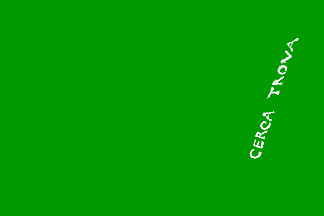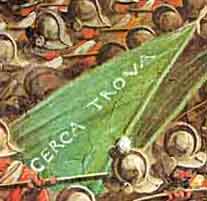
by António Martins-Tuválkin, 22 June 2005

Last modified: 2021-08-24 by rob raeside
Keywords: italy | florence | giorgio vasari | leonardo da vinci | vasari |
Links: FOTW homepage |
search |
disclaimer and copyright |
write us |
mirrors

by António Martins-Tuválkin, 22 June 2005

The detail from Vasari's fresco
from <vnexpress.net>
See also:
From Associated
Press, June 20, 2005:
"Cerca, trova - seek and you shall find - says a
tantalizing five-century-old message painted on a fresco in the
council hall of Florence's Palazzo Vecchio.
Researchers now believe these cryptic words could be a clue to
the location of a long-lost Leonardo da Vinci painting and are
pressing local authorities to allow them to search for the
masterpiece of Renaissance art.
Maurizio Seracini, an Italian art researcher, first noticed the
message during a survey of the hall 30 years ago, but his team
lacked the technology then to see what lay behind Giorgio
Vasari's 16th-century fresco, "Battle of Marciano in the
Chiana Valley."
However, radar and X-ray scans conducted between 2002 and 2003
have detected a cavity behind the section of wall the message was
painted on, which Seracini believes may conceal Leonardo's
unfinished mural painting, the "Battle of Anghiari."
Considered one of Leonardo's greatest works, the mural is known
today through the Tuscan master's preparatory studies and copies
made by other artists.
"At the time, this was considered the masterpiece of
masterpieces," Seracini told the Associated Press.
Recovering it "would be like discovering a new Mona Lisa or
a new Last Supper."
Leonardo's mural was thought to have been destroyed in the
mid-16th century when artist, writer and architect Vasari
renovated the hall that once served as Florence's seat of power.
He then covered the walls with his own paintings.
Leonardo began working on the "Battle of Anghiari" in
June 1505, when he was 53. He worked alongside fellow artist and
rival Michelangelo, who had been commissioned to decorate the
opposite wall with scenes of the Florentine republic's military
triumphs.
Michelangelo never went beyond the preparatory work for his
"Battle of Cascina," but Leonardo did paint his
battle's centerpiece - a violent clash of horses and men called
the "Fight for the Flag."
Leonardo later abandoned the work and left for Milan. Some
chroniclers of the time said the artist had experimented with
unstable paints that had rapidly degraded, leaving the painting
irreparably damaged.
"For generations these stories have held us back, but there
are documents that say otherwise," Seracini said.
"Maybe other parts were damaged, but we know that 60 years
later, when Vasari began his works, the painting was still
visible and people still came to marvel at it."
Vasari raised the hall's roof 23 feet by building a second set of
walls, but scans show that at one point he left a space between
the two walls that is just large enough to house Leonardo's
19-by-13-foot "Fight for the Flag," Seracini said.
A similar technique was used by Vasari to preserve other works of
art, he said.
"We see from Vasari's writings that Leonardo was just too
important to him," Seracini said, adding that Vasari himself
may have painted the message on a tiny green flag in his
39-by-26-foot fresco as a clue to the location of the
"Battle of Anghiari."
"It is the only writing on dozens of flags in that
painting," Seracini said. "And what are we looking for
if not for something which was already known then as the 'Fight
for the Flag'? Can all this be a coincidence?"
Seracini, whose research on another Leonardo painting is quoted
in Dan Brown's novel "The Da Vinci Code," is an
engineer who has spent the last three decades conducting
scientific investigations on art treasures. He said he would like
to continue his search for the "Battle of Anghiari" but
authorities in Florence have denied him a permit.
"For months now we have been at a standstill and since all
this is paid for by a private company, at no cost to the
municipality, it's difficult for me to understand the reason for
this behavior," he said.
Chiara Silla, director of the Palazzo Vecchio museum, said the
inquiry hasn't been given the go-ahead because Seracini has yet
to present a detailed report on his survey.
"Seracini's is a work in progress that is difficult to
evaluate," Silla said. "For the last two years we have
been waiting for technical and scientific documentation to decide
together whether to continue or not."
If authorized to resume, Seracini said he would conduct another
series of scans and insert a small probe through Vasari's
painting to detect any traces of the pigments used by Leonardo.
That would require at least another year of work, he said.
If the "Battle of Anghiari" is located, it should be
possible for conservation artists to remove a section of Vasari's
fresco, extract Leonardo's painting and then safely replace the
Vasari, Seracini said. He said it would be a fairly routine
operation for experts.
Alessandro Vezzosi, a Leonardo expert and the director of a
museum dedicated to the artist in his hometown of Vinci, said he
is aware of Seracini's work and that is based on solid evidence.
"We need to get to the bottom of this. The idea of a
Leonardo hidden there is incredibly fascinating," he
said."
Of course this is sinister-hoisted (i.e. with the hoist at the
viewer's right hand), as shown in the painting.
António Martins-Tuválkin, 22 June 2005